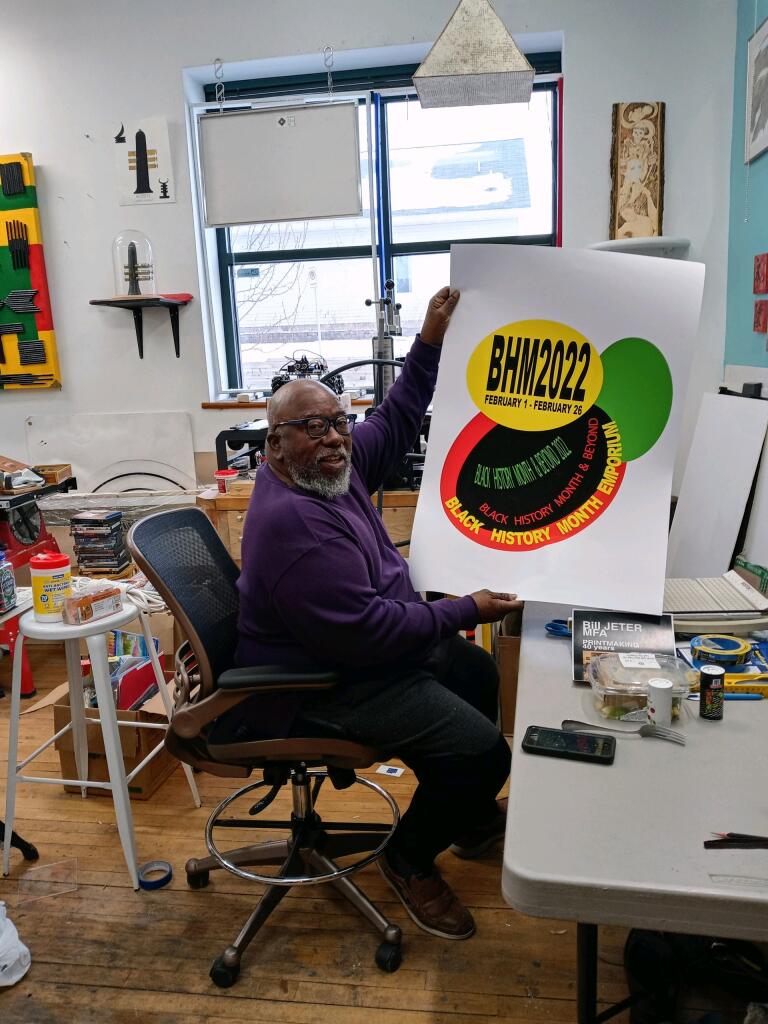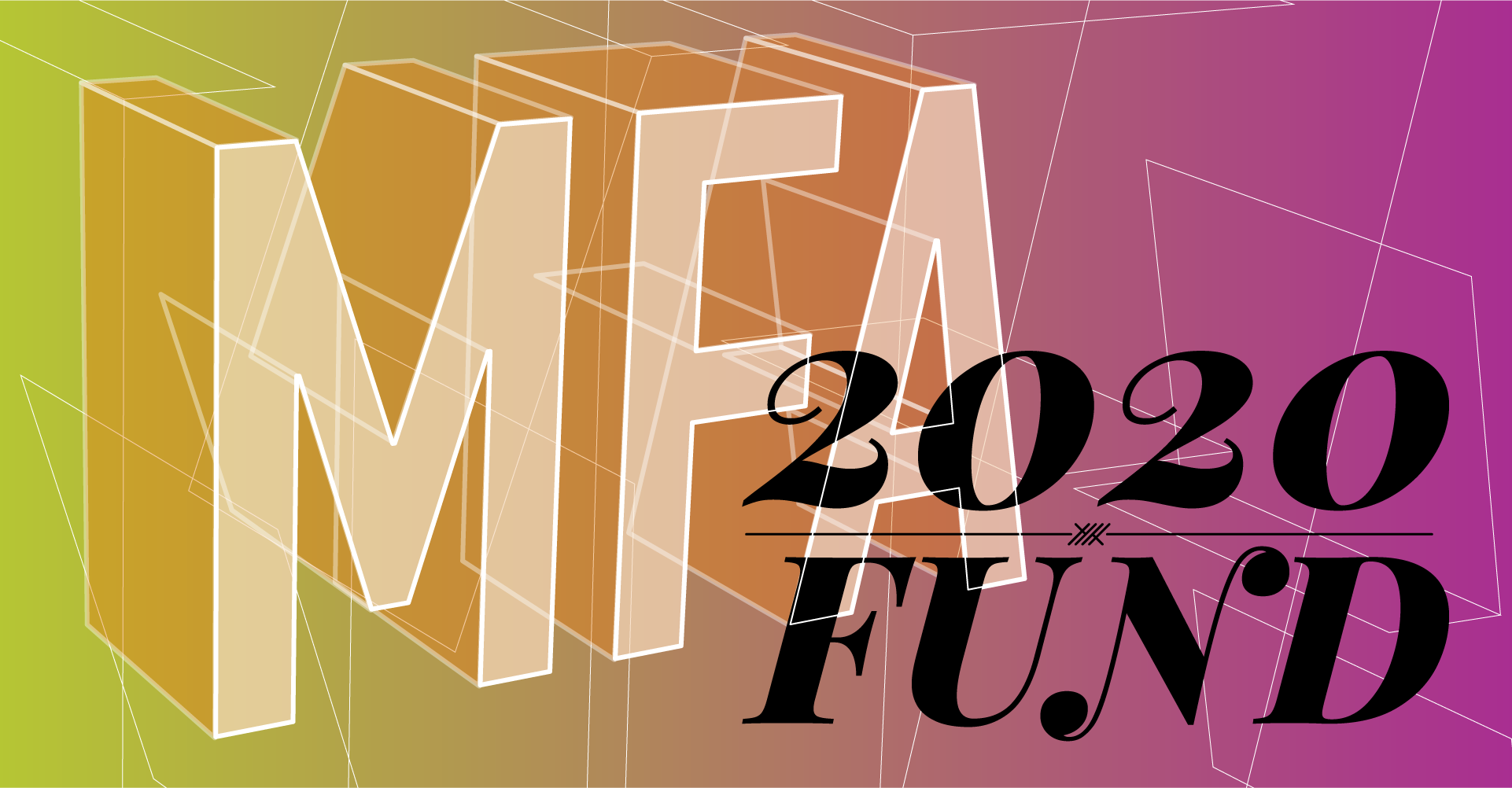Written by Amanda Rose ’23 | Images provided by Bill Jeter MFA ’98
I am very excited to share this fascinating interview with the MCAD MFA community. I had the opportunity to have an interesting conversation with an alumnus of the MCAD MFA program, Bill Jeter MFA ’98.
Bill has a BA in Art from Bates College in Maine and a MFA from MCAD. He has a socially conscious art practice and works with a variety of different materials. Bill is a resident artist at Homewood Studios – a gallery, studio for artists, and meeting space in North Minneapolis. Bill has many cultural, psychological and philosophical interests. He is interested in chemistry and physics, and is currently teaching himself about quantum physics.
— — — — — — — — — — — — — — —
AR:
Hi Bill, thank you so much for agreeing to participate! Now, onto the questions. Could you tell me more about your interests and the conceptual themes behind your work?
BJ:
I am fascinated by Harriet Tubman and I have done several pieces focused on her, like the screen printing of a Harriet Tubman $20 bill. Most people do not know that she fought in the Civil War, and fought on the side of the Union. She also had epileptic seizures and would fall asleep at random times. She would be traveling with enslaved people in order to free them but sometimes she would fall asleep in the middle of a trip and they would have to just wait for her to wake up. The idea of Harriet Tubman on the $20 bill is ironic because in 1857, Harriet bought her own mother for $20. $20, can you imagine that?
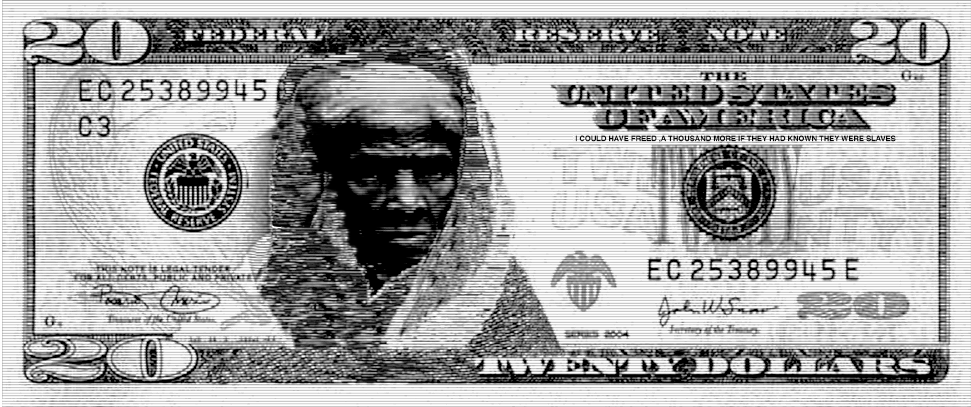
Bill Jeter, Harriet Tubman $20 Bill, screen print. Image courtesy of the artist.
So my art can be used for social activism. Growing up, I did not know any artists who were black who were not socially active. So the social activism aspect comes naturally to me. There is something very unique about the narrative of America and African American thought, and justice and all of that. One of the things I have done is create a poster. I have taken this idea of “Black” and turned it into the element carbon. I started looking at these things on a cosmic scale. There is a lot more happening, and this atom of carbon looks like a target. We are all made of carbon, living black matter. So we are all made of black matter, carbon.
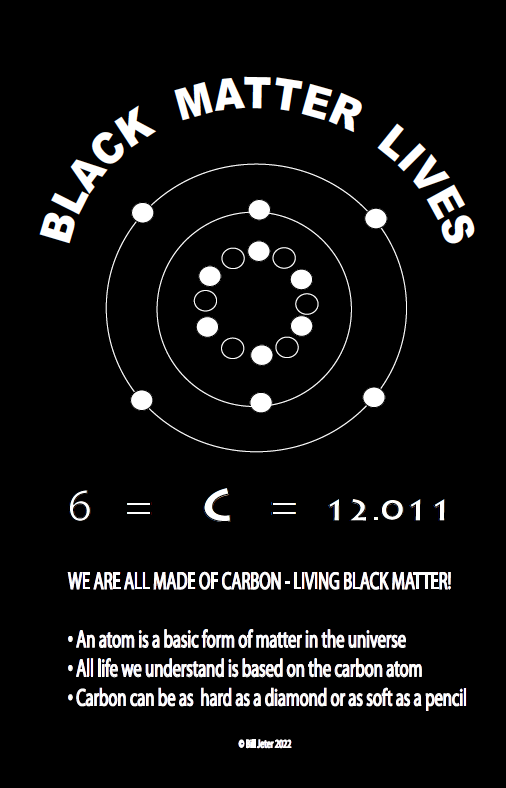
Bill Jeter, Carbon-12 BLM, 2022. Image courtesy of the artist.
They put up this new telescope, the James Webb Telescope. It does not see with eyes. It is using heat sensors and looking for carbon signatures. That is how they are going to know if they find anybody, they are going to know by the carbon that they can see around the star or by the carbon atoms. They can see around those planets. That is how they are gonna know that there might be something there. They are not going to be looking for diamonds, and they are not going to be looking for white people in cities. They are going to be looking for trace chemicals.
There is some sadness in some of that in our deep, dark future. If we do not get our act together. If someone comes here and looks, all they are going to see is a layer of hydrocarbons that can circle the whole world. And there will be a circle inches thick, and that will be all our plastics and all of our stuff that we made. And that is all they will know about us. Everything else will be gone if we do not get our shit together, excuse me. But these kinds of things are a little more humanistically relevant to what we really need to think about the most. That way little kids would not be dying over there in Europe right now. They would not be dying in South America, and other places, and we would not be having these kinds of discourse; because we literally are carbon.
If you do not believe that, it is something that unfortunately, every firefighter understands because they have to go into those buildings. They have to find those people. That is why they all look the same. They have been burnt down to the carpet. They are carbonized, which is what we really are. From that point of view, we are all this black matter. So in some strange sense, you know, Black lives do matter. It is a form of living substance and it is the only element we know that can support the kind of life we are.
So this poster represents the carbon atom. It has the electrons, the protons, the neutrons and the layout. And because of the layout, it is really able to attach and adapt more than any other kinda pattern. That is why it is in so many different things. And that is why we can make plastics and we can do all this stuff. It is all made out of carbon. I became aware that my carbon atom design resembled a ‘target’ as I made it. I thought of Jayland Walker, shot 46 times in 2022 by police officers.
AR:
That is really powerful, thank you for sharing Bill. I had not made that connection before. So, why do you refer to some of your work as “documents”?
BJ:
Some of my artwork is not images at all. It is text, text based stuff. I started that when I was doing jazz a lot of the time. In my work, jazz was multicolored images and patterns and big splashes of color. Then I started doing it with words and with repetitive improvisational marks, and things like that. I will not call it “realer”, but it does feel like I am getting closer to the center of what I am trying to say or do when I am looking at things like that.
AR:
I have noticed that you have several pieces focused on the $20 bill.
BJ:
Yes, even though it looks like a $20 bill it goes far beyond that. It has to do with cosmic connection. I mean, George Floyd was literally killed because they said he had a fake $20 bill. So this $20 bill keeps drifting back and forth to me.
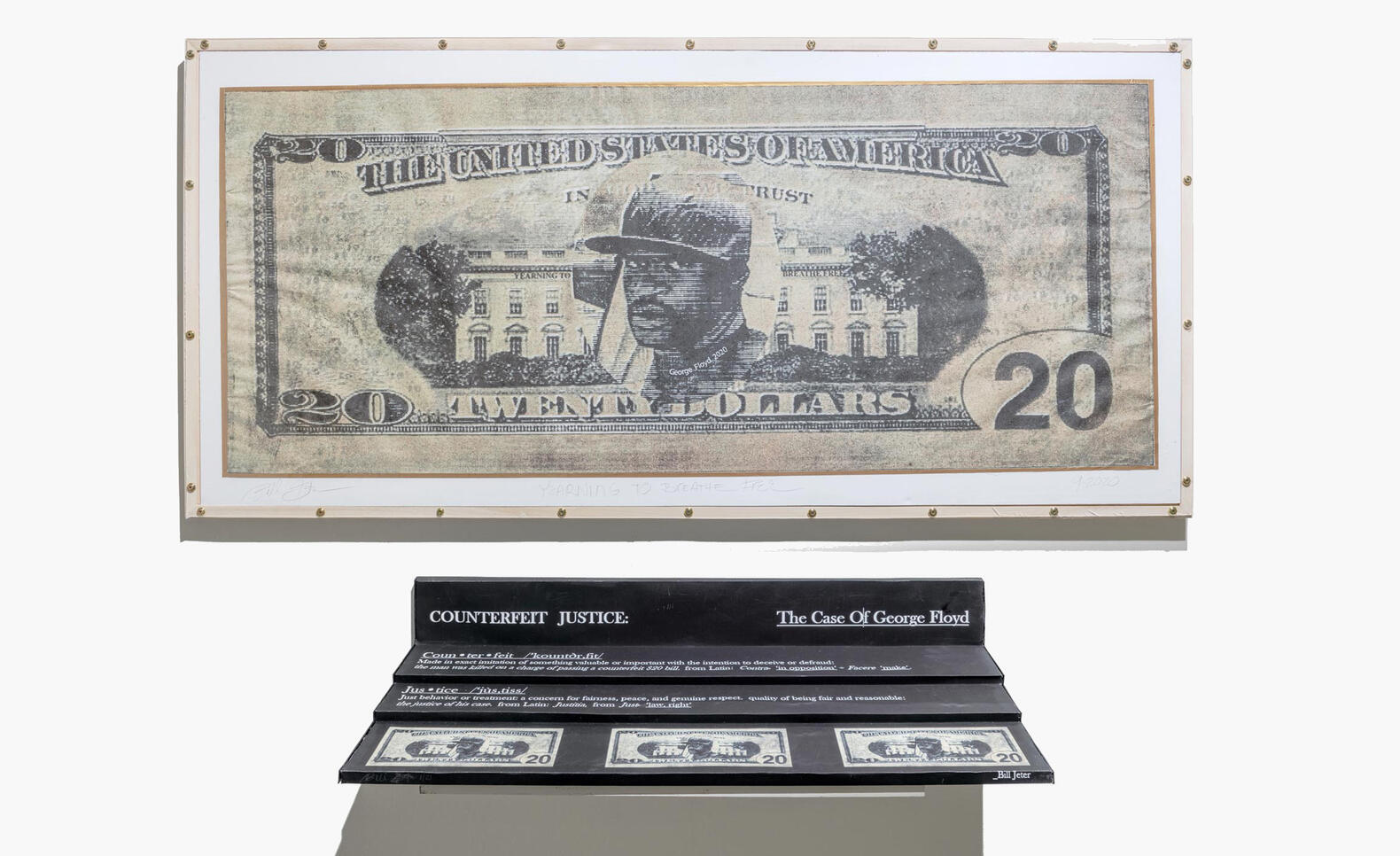
Bill Jeter, COUNTERFEIT JUSTICE: The Case of George Floyd, 2020. lithograph print. Image courtesy of the artist.
One of those pieces was created when Trump first got into office. Some people wanted to get it removed, but there is a poem on the Statue of Liberty, one of the lines is “yearning to breathe free”. I try to look for those kinds of things, because I have an academic background as well as an artistic background.
I am poised to be able to do this kind of stuff. The research is not that hard for me, the research is an art activity. It is like when people say they are going to make a painting and the first thing they do is start doing studies and things like that. So, let’s say I am going to make a painting or I’m going to make a print. The first thing I start doing is looking up stuff and reading things, processing information, looking at old materials about how things were made and what they were made out of, things like that. So I am trying to make something, but I also want to do some reflection and examine some things.
AR:
That is a really interesting way to begin your work. You are definitely combining a lot of different concepts that I would not think would go together, but they actually make sense, like those cosmic connections that you were talking about.
BJ:
Well, Iam not a religious person. But as far as philosophy goes I think Jesus is probably one of the greatest philosophers I have ever read, as someone who actually can speak and talk like that. I do not think that if I do not sin and I do not drink and I do not smoke, then I go to heaven. I don’t believe in that. But I think you do unto others as you would have them do unto you. I try to live my life that way.
I think I am fluent in different kinds of cultural thoughts and processes. I have had the opportunity to learn about them and read about them, and to some extent immerse myself in different cultures and travel a little bit and, and see things. There is a difference between being fluent and being affluent. I start with those kinds of thoughts, like, what is the difference between this and that? For example, the word “handsome” used to refer to a guy who drove a horse and buggy. They just figured out that if they dressed up a little bit and put on a nice jacket and a coat, they would be able to give more rides to people. So they became “handsomes”. This is all Old English. So you had a handsome driver who helped you step up to the carriage and helped you out. That’s what handsome was.
AR:
Wow, I did not know that!
BJ:
Everything that we have is like that but we do not think of it. Those words trail each other through history and they are attached to it. They might mean something different in another time period, but they will always have that root hanging onto them. Therefore, they have all of these connotations that can be regurgitated back.
That is why it is so difficult to process things like the n-word and other things like that. Because even though you try to make it upbeat and funny and hip and somehow relevant, it still drags all that history with it. History is very, very difficult to erase from it. It is one of the few words I know now where even if you are rich and you say it, you still get busted. That is one of the few. Rich people can get out of most kinds of things, but they do not get out of that. Trump says a lot of things, but he is smart enough not to say that. It is just so charged, even playing around and joking with it has gotten people in trouble.
AR:
I was wondering if you could tell me more about your thoughts behind starting the Black History Month Emporium Show, which has now become an annual show at Homewood Studios.
BJ:
Well, that comes out of my nature, out of my history. I was in high school from 1968 to 1972 in this country. You just look at the history and you can see from the death of Martin Luther King to the ’72 Olympics, to all, all those images you see on the posters I grew up through right then in high school and middle school, through all of that, you know, all of those things. And so it was a very activist time. 69, I’ll be 70 years old in November. And I had African American black history classes, black history month, black history classes in my high school, which is a public school. That was 50 years ago. Hmm. Now it is considered critical race theory and people do not want this in our schools and they are not sure how it is going to hurt kids.
I grew up in New Jersey, in a part of the country that was not segregated. I had kids who were white in my classes from kindergarten to high school. So, white people who are my age had black history in high school as part of their education. I know they did, because some of them were my friends. We had those courses. This is not new thinking. This is stuff that is over half a century old.
As I got older, I thought that way of instructing would continue. However, when I started meeting African American kids and white kids, because I taught for 23 years at Perpich, I noticed some things. One of the things that I saw a lot happened with kids who were from greater Minnesota. They came from little tiny towns, but in class they got to know me and they got to know who I am and everything.
At the end of the year, I had kids coming to me, one girl in particular, she came to me and she said, “Bill, when I first came here, I was afraid. My grandfather would not be able to speak to you on our farm. My father would never be able to shake your hand.” She said, “When I first came here, I did not know that the palm of my hand was the same color as the palm of your hand. I thought Black people were black, everywhere. I did not know that there were subtleties. You have taught me so much, you know? And I have learned so many things.”
It was through those experiences that I realized that the work is not done. How can kids 25 or 40 years later not know these things that I was taught when I was their age? Now people are trying to make laws to shut down critical race theory. It is only gonna make us worse as a country in our cultural aspects, who we are as a people, and what we value. It is so shortsighted and frankly, I do not think it can be done. You tell kids they cannot do something or they should not read something and that is exactly what they are going to do.
About Bill Jeter MFA ’98
“I was born legally blind in one eye in the middle of the last century. I have spent forty-five years developing my visual and intellectual acuity through a life in art and arts education. I have both undergraduate and graduate degrees in visual art. I have a BA in Art from Bates College in Maine and an MFA from MCAD. I have exhibited, been collected, lectured, and traveled nationally and internationally through my work. As a manufacturer of meaning I dissect languages using histories, symbols, and cultural references. I am interested in art and language as tools to pose questions about human experience. I create images, objects, and documents that are stories about culture and experience. I extend materials and concepts into forms. I have been based at Homewood Studios in North Minneapolis for the past sixteen years where I have strived to aesthetically create work as well as develop a socially conscious art practice. I taught at the Perpich Center for Arts Education for twenty-three years as a principal studio art instructor, mentoring hundreds of amazing student artists. Some are now world-renowned in many fields including the visual arts.” ( Source )
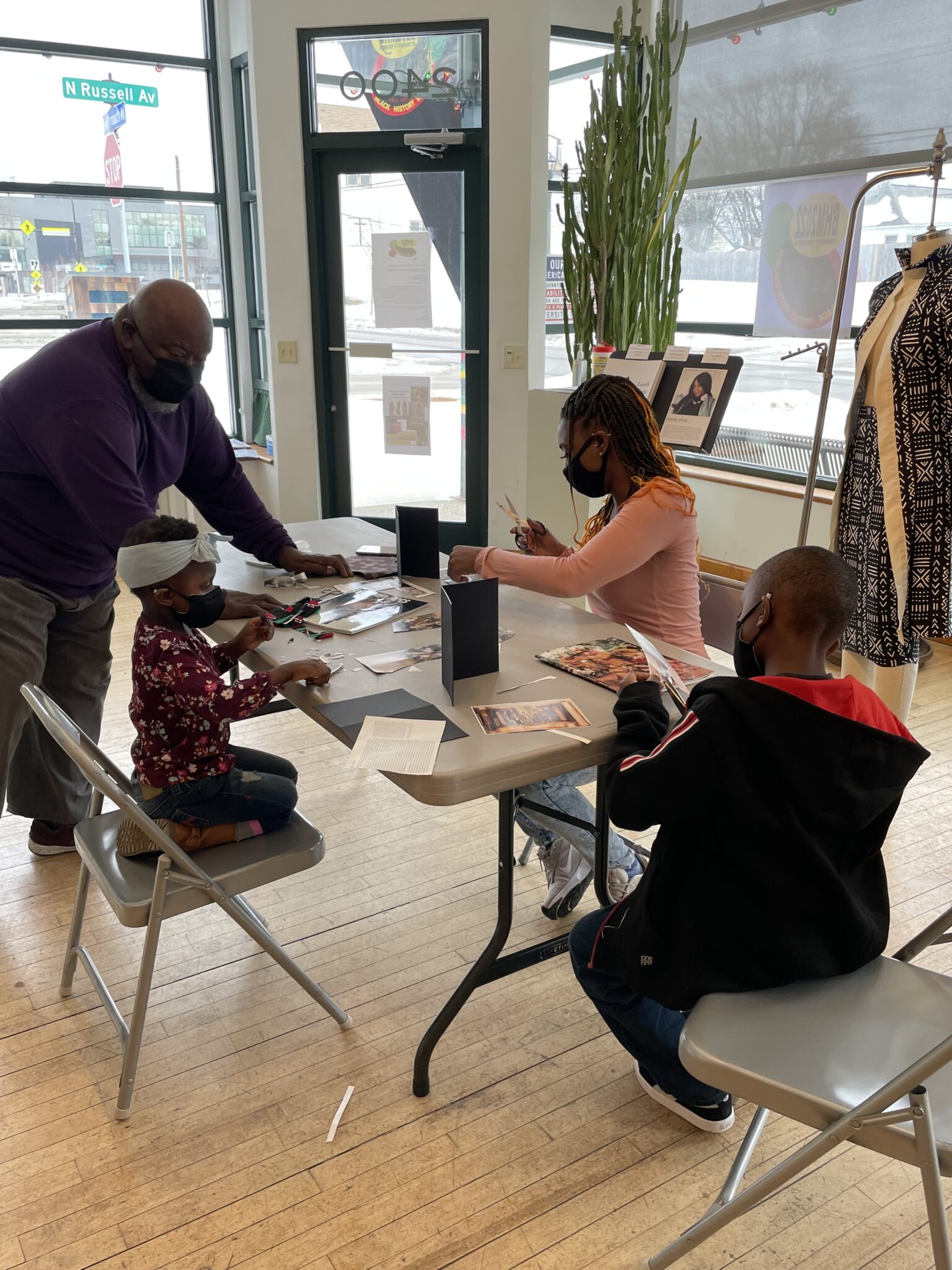
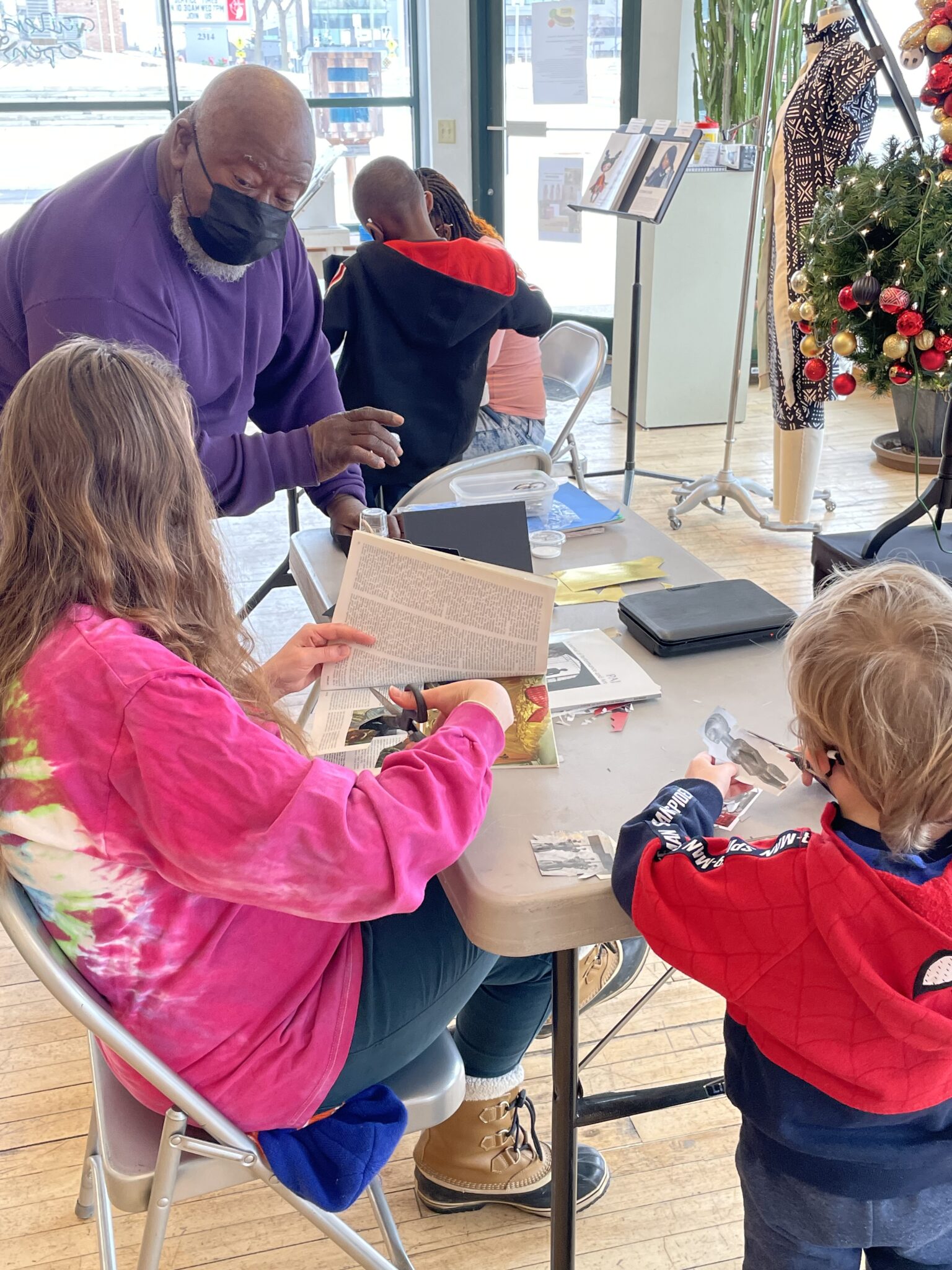
Bill works with children during a Youth Art Day as part of BHME 2022.


